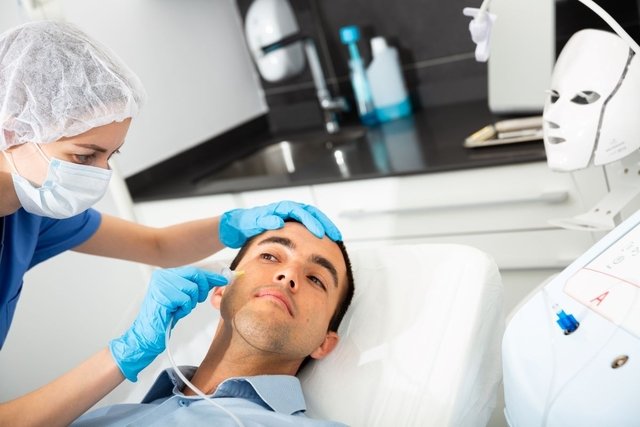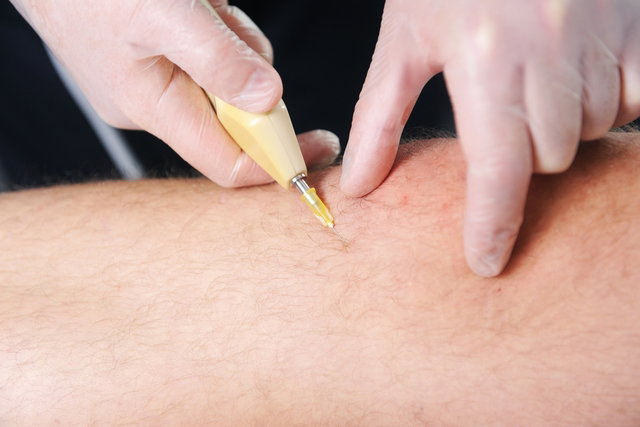Carboxytherapy is an aesthetic therapy that consists of applying carbon dioxide under the skin to treat cellulite, stretch marks, localized fat and also to eliminate sagging.
The carboxytherapy technique can be used for different types of treatments, both facial and body, and allows you to increase collagen production, combat localized fat and destroy fat cells, being widely used on the face, belly, sides, arms or thighs. .
In order to have all the benefits of carboxytherapy and lasting results, the therapy must be carried out by a dermatologist, dermatofunctional physiotherapist or beautician qualified to apply the technique.

What is it for
Carboxytherapy is typically indicated to treat:
- Cellulitis: improves blood circulation and causes a rearrangement of adipose tissue, increasing local lymphatic drainage. Understand how carboxytherapy for cellulite is performed;
- Stretch marks: The infusion of gas under the stretch mark causes the skin to detach, stimulating collagen production and improving the healing process. See how carboxytherapy for stretch marks works;
- Localized fat: favors the breakdown of fat cells and improves blood circulation at the injection site. Find out more about carboxytherapy for localized fat;
- Flaccidity: the inflammatory process, resulting from the injection of carbon dioxide, favors the production of collagen fibers, which support the skin, leaving it firmer and less flaccid;
- Dark circles: increases blood circulation in the skin close to the eyes and, consequently, the arrival of oxygen to the tissues, reducing swelling and easing dark circles. Discover some homemade options to remove dark circles;
- Loss of hair: favors the growth of new hair strands, by stimulating increased blood flow to the scalp;
- Acne Scar: increases blood circulation in the area, stimulating the production of collagen and elastin, which give firmness and support to the skin, reducing acne scars.
The number of carboxytherapy sessions may vary according to the objective of the treatment and the area to be treated. Therefore, there must always be a recommendation from a dermatologist, who will carry out an assessment before and after applications to determine the number of sessions necessary.
How carboxytherapy works
Carboxytherapy is carried out using a fine 0.30 x 13mm needle, attached to a cylinder of medicinal carbon dioxide, which is regulated by the professional performing the procedure, after evaluating the skin and cleaning the area with 70% alcohol.
The gas causes a small detachment of the skin, filling the region with air and stimulating blood circulation. It is essential that the procedure is carried out in a safe place and with a qualified professional.
Does carboxytherapy hurt?
Carboxytherapy can cause minor discomfort, as the entry of the gas causes a small detachment of the skin. However, the pain is temporary, and passes after about 30 minutes, improving little by little, as well as the swelling and redness, which may also appear in the area.
Risks and side effects
Carboxytherapy is an aesthetic treatment that can generate some risks, such as prolonged pain, which can last for more than 3 days after application and the appearance of small bruises in the region where it was treated. After the procedure, it is common to observe some side effects on the skin, such as:
These risks and side effects are also related to the way in which carboxytherapy is carried out, and it is essential that the professional is aware not only of the possible effects it can generate, but also of executing the appropriate technique so as not to cause any harm to the patient.
Contraindications
Carboxytherapy is contraindicated in patients with autoimmune diseases, people who show signs of skin infection and inflammation, gangrene or who have diseases such as epilepsy, cardiorespiratory failure, kidney or liver failure or severe uncontrolled high blood pressure.
Furthermore, carboxytherapy should also be avoided during pregnancy.
Bibliography
- DORNELES Ildete AO et al. Evaluation of the effectiveness of carboxytherapy in improving tactile sensitivity, body satisfaction and the appearance of striae alba in the gluteal region in women: a randomized clinical trial. Fisioter Bras. 22. 3; 456-68, 2021
- NANTES Mariana C. et al. ACTION OF PHARMACOLOGICAL ACTIVES ASSOCIATED WITH INTRADERMOTHERAPY, MICRONEEDLING AND CARBOXYTHERAPY TECHNIQUES IN THE TREATMENT OF STRETCH STRETCHES. Brazilian Journal of Surgery and Clinical Research – BJSCR. Vol.27. 2; pp.82-89, Jun – Ago 2019
- LEE, Georgia S. K. Quality survey on efficacy of carboxytherapy for localized lipolysis. J Cosmet Dermatol. Vol.15(4). 484-492, 2016
- BRAZILIAN SOCIETY OF AESTHETIC BIOMEDICINE. Carboxytherapy. 2019. Available at: <https://sbbme.org.br/carboxiterapia/>. Accessed on November 15, 2019
- PIANEZ, Luana R. et al. Effectiveness of carboxytherapy in the treatment of cellulite in healthy women: a pilot study. Clin Cosmet Investig Dermatol. Vol.9. 183-190, 2016
- Tuane Fernandes Pacheco. Effects of carboxytherapy on fibroedema-geloid in the posterior thigh region . Course Completion Work, 2011. Universidade do Extremo Sul Catarinense.

Sign up for our newsletter and stay up to date with exclusive news
that can transform your routine!
Warning: Undefined array key "title" in /home/storelat/public_html/wp-content/plugins/link-whisper-premium/templates/frontend/related-posts.php on line 12
Warning: Undefined array key "title_tag" in /home/storelat/public_html/wp-content/plugins/link-whisper-premium/templates/frontend/related-posts.php on line 13





